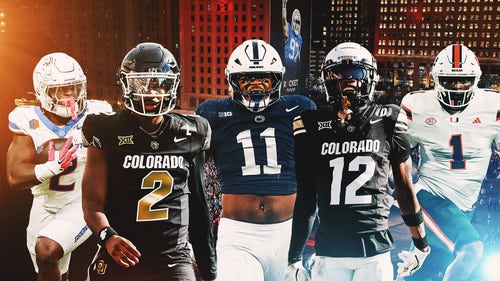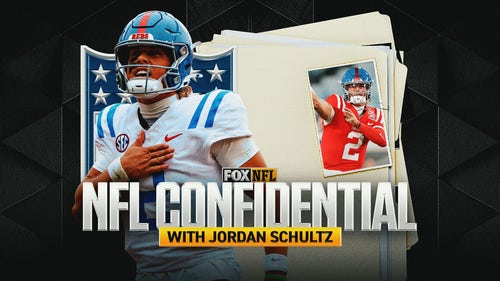
Parallel universe: Why Seattle TD was good
We’re nearly a third of the way into the 2011 NFL season and about the only thing you can count on is . . . you can’t count on what you think might happen.
Week 5 proved to be reliably unreliable. But isn’t that what makes the NFL so great? It’s predictably unpredictable.
For instance, who could have guessed that these things would happen?
• The Eagles lose for the fourth time in five games as the Bills pick off Michael Vick four times.
• The Raiders win their third game, holding on for an emotional road win against Houston the day after owner Al Davis passes away.
• The Seahawks rally to beat the Giants in the Meadowlands, with their backup quarterback, for their third win.
• The Vikings finally get their first win, five games into the season, in a blowout over the Cardinals.
• The surprising 49ers blasting the Bucs for their fourth win in five games.
And talking about surprises, we haven’t even gotten to the calls on the field yet.
There were some rare occurrences Sunday: a play in which I had several people contact me at my “Ask Mike” mailbag, questioning why an unabated penalty wasn’t called on a touchdown; an unusual 5/15 penalty; and the first review of a safety initiated by the replay official since the new rule was put in this season.
But let’s begin with the touchdown in the Seahawks-Giants game, a play that some thought should have been stopped by an unabated offside penalty call on the Giants’ Osi Umenyiora.
THE SITUATION: Seattle had the ball, second-and-10 at the New York 27-yard line with 2:42 left in the game. The Giants led 27-23.
THE PLAY: Seattle quarterback Charlie Whitehurst threw a 27-yard touchdown pass to Doug Baldwin. Umenyiora was called for offside and the penalty was declined.
MY TAKE: I got lots of tweets on this play, asking why this play was not shut down and “unabated to the quarterback” called.
What is unabated to the quarterback? Rule 7, Section 4, Article 4 of the NFL rule book states: It is a neutral zone infraction when, "a defender moves beyond the neutral zone prior to the snap and is parallel to or beyond an offensive lineman, with an unabated path to the quarterback or kicker. Even though no contact is made, officials are to blow their whistles immediately."
On this play, Umenyiora was not close to being parallel to the offensive lineman when the ball was snapped. Therefore, this is strictly a live-ball foul for being offside. And yes, the rule says the kicker gets the same protection.
Raiders at Texans
THE SITUATION: Houston had the ball, first-and-10 at the Houston 48-yard line with 1:22 left in the game. Oakland led 25-20.
THE PLAY: Houston quarterback Matt Schaub was sacked by Oakland’s Tommy Kelly. A penalty was called on Houston’s Mike Brisiel. It was declined. However, the replay assistant called for a review to see if the Raiders had too many players on the field. The review showed Oakland did have 12 men on the field, so the penalty against Brisiel was enforced for 15 yards and the penalty against Oakland for 12 men on the field was disregarded by rule.
MY TAKE: If this didn’t confuse you, nothing will. Maybe I should just say they got it right and leave it at that. But I can’t.
Let’s start at the beginning: Brisiel was correctly called for a personal foul, a face mask penalty. Schaub was sacked on the play, so the Raiders declined the penalty, which made it second-and-19. The replay official, trying to confuse us all, asked for a review.
For what? He saw that the Raiders potentially might have had 12 players on the field. Replay showed that the Raiders’ 12th player, who was trying to get off the field, still had a foot on the ground inbounds when the ball was snapped. Therefore, a penalty for 12 men on the field was put on the play. It’s one of the few penalties that replay can create. The officials then had to go back and put back on the face mask penalty that originally was declined. That left two fouls on the play, a major face mask and a minor 12 men on the field penalty.
Since there was no change of possession on the play, this enforcement is called a 5/15. The rule book states that fouls by both teams (double fouls) before a change of possession offset, except "if one of the fouls is of a nature that incurs a 15-yard penalty and the other foul of a double foul normally would result of a loss of 5 yards only, the major penalty yardage is to be assessed from the previous spot."
Therefore, the 15-yard face mask was enforced, making it first-and-25 for the Texans, and the 12 men on the field penalty was disregarded. Like I said, I should have left it as they got it right.
Seahawks at Giants
THE SITUATION: The Giants had the ball, first-and-10 at the New York 5-yard line with 7:07 left in the third quarter. The score was tied 14-14.
THE PLAY: Giants running back D.J. Ware was tackled in the end zone by Seattle’s Anthony Hargrove for a safety. The replay assistant initiated a review to see if the runner broke the plane, and the play was upheld.
MY TAKE: I think this is the first time that the ruling of a safety resulted in the replay official initiating a review. This is the new rule that involves all plays that are ruled a score, including safeties, field goals and extra-point attempts. Once a score is ruled, the replay official has to confirm that the ruling was right or initiate a review by the referee.
In order for this not to be a safety, the entire ball must get out into the field of play. If any part of the ball is still over the goal line, then it would be a safety. It was very hard to tell in replay whether that happened. There was clearly not enough evidence to overturn the call of a safety.
Jets at Patriots
THE SITUATION: New England had the ball, second-and-6 at the New York 6-yard line with 13:12 left in the third quarter. The Patriots led 10-7.
THE PLAY: New England quarterback Tom Brady completed a 4-yard pass to Deion Branch, who appeared to fumble the ball. It was recovered by the Jets’ Mike Devito. New England challenged the fumble ruling and the play was reversed. The Patriots were given the ball back on the New York 2-yard line, and they scored on the next play.
MY TAKE: This was a good challenge by New England. When an offensive player has possession of the ball while on the ground, he is considered to be down at the instant he is touched by a defender.
Although Branch shifted the ball from his right to his left hand, the contact actually came before the ball moved from one hand to the other. Even if the ball was being shifted when the contact occurred, I do not consider that loss of possession.
Once again, the key is that as long as Branch’s knee was on the ground the play becomes dead immediately when he is first touched.
Cardinals at Vikings
THE SITUATION: Minnesota had the ball, first-and-15 at the Arizona 47-yard line with 12:04 left in the third quarter. The Vikings led 28-3.
THE PLAY: Minnesota quarterback Donovan McNabb completed a 6-yard pass to Michael Jenkins, who appeared to fumble the ball that was recovered by the Cardinals’ Rashad Johnson. The play was ruled that Jenkins was down by contact. Arizona challenged the fumble ruling, and the play was reversed to a fumble that was recovered by the Cardinals.
MY TAKE: A lot people have inquired about this play as well. The main question that was being asked was regarding the whistle. The whistle seemed to blow when the ball was loose and before the recovery.
Guess what, folks? It makes no difference when the whistle blew. This play is reviewable all the way through to the recovery, regardless of the initial ruling or when the whistle may have blown. Players are told to play through the whistle when the ball is loose.
Once in replay, two things have to be confirmed in order for the ruling to be reversed. First, you must confirm it’s a fumble. Second, there must be a clear recovery. Since both of these were confirmed, Arizona was given the ball.
Saints at Panthers
THE SITUATION: Carolina had the ball, third-and-11 at the Carolina 46-yard line with 2:52 left in the first quarter. The Saints led 10-0.
THE PLAY: Carolina quarterback Cam Newton completed a 54-yard touchdown pass to Steve Smith. A personal foul penalty was called afterward on New Orleans’ Roman Harper for a late hit on Smith in the end zone.
MY TAKE: This was a cheap shot by Harper. It is not the type of late hit that would be considered for a possible ejection.
When it comes to ejection, you look more of a windup and a punch or a kick. Other things could lead to an ejection, too, but those are the common ones. After Harper’s late hit, a skirmish developed in the end zone and there was pushing and shoving and even an attempt to throw a punch.
The only penalty that was called was the hit on Harper, and I like that. He instigated this whole mess and, to me, offsetting personal fouls are meaningless. Often, it seems the officials catch the second act, but this time they got the true culprit and ignored what happened after that. That’s the way it should be.
You can follow Mike Pereira on Twitter right here.










